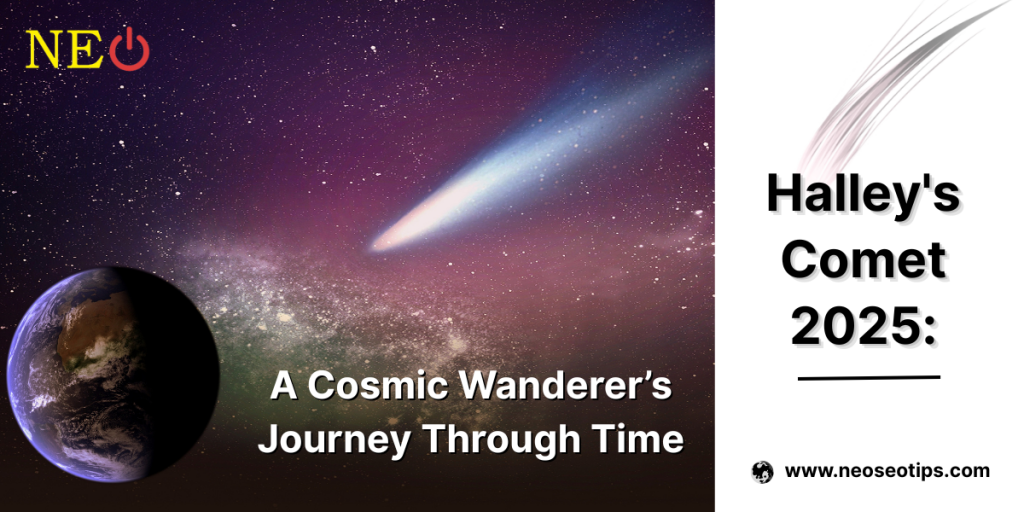Halley's Comet, officially designated 1P/Halley, is a periodic comet that draws skywatchers once every 76 years. Named for astronomer Edmond Halley, who predicted its orbit in 1705, it is a celestial icon. It is the only comet with a short period that can be seen with the open eye. As it approaches the Sun, gas and dust are released from its potato-shaped (15 km by 8 km) nucleus, which is composed of ice, dust, and rocky material. This results in a glowing coma and tail. Halley's Comet is famous for its historical appearances, spanning from the Battle of Hastings in 1066 to its 1986 flyby, inspiring awe in people of all ages and bridging the gap between science and culture.
Halley's Cosmic Journey:
Halley's Comet is still a far-off visitor in 2025, far from Earth's skies but always present in our fascination with the universe. Its legacy is evident in the Eta Aquariid meteor shower, a stunning show connected to its debris, even though it isn't visible this year. Anticipation for its spectacular return in 2061 grows as we follow its trajectory after aphelion in December 2023. This blog provides astronomy enthusiasts with a cosmic guide by delving into Halley's current status, meteor showers, and scientific and cultural significance.
In 2025, where is Halley's Comet?
Around 35 astronomical units (AU) from the Sun, outside of Neptune's orbit, Halley's Comet is cruising through the constellation Canis Minoris as of May 2025. It is now traveling slowly inward, speeding up toward its next perihelion in July 2061, after reaching its furthest point (aphelion) in December 2023. Halley is still a silent nomad, too far away and too faint to be seen even with telescopes. Accurate tracking is a marvel of modern astronomy because its orbit, which lasts an average of 76 years, varies slightly due to gravitational pulls from planets like Jupiter.
The Eta Aquariid Meteor Shower: Halley's Present for 2025
Despite not being visible, Halley's Comet shines through the Eta Aquariid meteor shower, which peaked on May 5–6, 2025. Every year, when Earth passes over Halley's debris trail, particles burn up in our atmosphere, causing streaks of light to ignite. In 2025, observers in the Southern Hemisphere saw up to 60 meteors per hour, compared to 10 to 30 for those in the Northern Hemisphere. Choose a rural, dark location, face the Aquarius constellation after midnight, and allow your eyes to acclimate for the best view. We are reminded of Halley's lasting cosmic imprint by the Eta Aquariids.
2061 and Beyond: The Next Great Appearance
Make sure to mark July 28, 2061, as the date of Halley's Comet's closest approach to the Sun, or perihelion. The 2061 apparition promises a spectacle, especially for viewers in the Northern Hemisphere, in contrast to its unimpressive 1986 showing when it was ill-positioned. Halley will compete with the brightest stars, with an apparent magnitude of -0.3. Looking farther ahead, it will burn at magnitude -2 in 2134, passing only 0.09 AU (13 million km) from Earth. Halley's reputation as a once-in-a-lifetime wonder will be solidified by these upcoming displays.
Halley's Comet: The Science Behind It
A fundamental concept in comet science is Halley's Comet. Its nucleus was discovered to be a dark, icy body with jets of gas and dust in 1986 by the European Space Agency's Giotto mission. It is among the darkest objects in the Solar System due to its low albedo, which only reflects 3% of light. Halley is a rare comet that can be seen without telescopes because it is a short-period comet, completing its elliptical orbit every 74–79 years. Because of its consistent returns, scientists have been able to investigate cometary evolution, which has helped them understand the origins of the Solar System and how comets contribute to the delivery of water to Earth.
The Historical and Cultural Values of Halley:
Human history is intertwined with Halley's Comet. Before the Battle of Hastings, its appearance in 1066, which is preserved in the Bayeux Tapestry, was interpreted as a portent. Though this is still up for debate, some people believe it served as inspiration for the Star of Bethlehem. Halley inspired wonder and terror for centuries, showing up in literature, art, and folklore. When Earth passed through its tail in 1910, it sparked public fascination and fear. Halley now represents humanity's pursuit of cosmic understanding by fusing science and narrative.
How to Track and Explore Halley’s Comet:
While Halley’s Comet isn’t visible in 2025, you can track its journey using tools like TheSkyLive.com or the Sky Tonight app, which offer real-time positional data. To dive deeper, explore NASA’s comet resources, or join local astronomy clubs for stargazing events. The Orionid meteor shower in October 2025, another Halley-linked event, offers another chance to connect with its legacy. Share your meteor shower photos online or download an astronomy app to stay engaged with the night sky.
In conclusion, it is worth waiting for a comet-
Halley's Comet continues to inspire with its meteor showers and legendary past, despite its distance in 2025. On its way back in 2061, it serves as a reminder of our place in the cosmos—a brief but amazing moment in cosmic time. Regardless of your level of expertise in astronomy or your interest in stargazing, Halley's legacy encourages you to gaze up, dream big, and wait for its next spectacular show. Awaken your cosmic curiosity by joining the astronomy community, following its trajectory, and letting Halley's story pique your interest.









